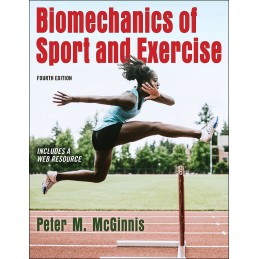This is the loose-leaf version of B
iomechanics of Sport and Exercise, Fourth Edition With Web Resource, which offers students a lower-price printed version of the text. Other binding options are also available.
A standout among introductory biomechanics texts,
Biomechanics of Sport and Exercise, Fourth Edition With Web Resource, takes a unique approach to introducing exercise and sport biomechanics. Using simple terms, the book presents mechanics before functional anatomy, helping students first understand external forces and their effects on motion; then explores how the musculoskeletal system responds and generates its own internal forces to maintain position; and finally shows how to apply biomechanical principles to analyze movement and ultimately improve performance.
The fourth edition expands its commitment to enabling students to discover the principles of biomechanics through observation. Easy-to-understand experiments are presented for students to try in the classroom or on their own. Sample problem sidebars guide students through choosing the appropriate equation to determine the forces acting or motion occurring in a specific scenario and then helps them solve the equation. This practical approach—combining clear illustrations, sample calculations, and encouragement for active learning—helps students develop a deeper understanding of the underlying mechanical concepts.
In addition to careful updates throughout the book, other new enhancements in the fourth edition include the following::
- New content explores the technologies and devices available to coaches, athletes, and the general public to measure aspects of athletes movements.
- New full-color art and diagrams enhance the text and help students visualize mechanics in real-world scenarios.
- Explanations of the equations used in the text make the content more accessible to students.
- New concept application boxes provide deeper analysis of the field use of biomechanics, with topics such as the Magnus effect in baseball pitching, the wetsuit effect in triathlons, power output in cycling, centripetal acceleration when running a curve, and the work-energy principles in modern shot putting.
Other learning aids include bold key terms, chapter objectives, and a guide to key equations and abbreviations. The chapters include a total of 18 sample problems that students can solve using a step-by-step process. A companion web resource offers additional review questions and problem sets.
Biomechanics of Sport and Exercise, Fourth Edition, introduces the biomechanics of human movement in a clear and concise manner while promoting an active, engaged learning experience. Students will discover the principles of mechanics for themselves, resulting in a strong understanding of the subject matter.




 Delivery policy
Delivery policy
 Security policy
Security policy
 Return policy
Return policy
